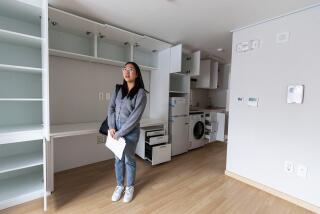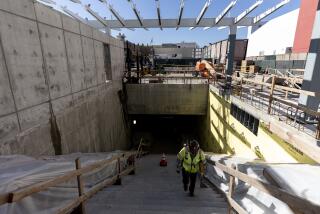Buses Remain Most Popular Transportation : Seoul’s New Subway Is Short of Riders
SEOUL, South Korea — The city of Seoul recently completed two new sections on its subway line, extending it to 72.8 miles of track and making it the seventh longest in the world behind New York, London, Paris, Moscow, Tokyo and Chicago.
The problem now, however, is to get more of the city’s 10 million people to ride it.
In addition to cutting commuting time in half for some people, it offers exhibitions of art and culture along with shopping arcades, snacks and reading materials.
City officials hope the subway will help unclog Seoul’s surface traffic and keep things moving during next year’s Asian Games and the 1988 Summer Olympics, which are to be held here.
The recent dedication of lines No. 3 and 4 means the system can handle 5 million people a day, authorities say, but the the daily average so far has been only about 1.9 million people, well below the hoped-for 3.1 million. The Seoul Metropolitan Subway Corp. predicts, however, that the number of riders will increase sharply as more travelers get accustomed to the expanded system.
The most popular form of public transport in Seoul has been the bus--about 8,500 of them. Statistics show that of more than 16 million rides a day on all forms of transportation, nearly two-thirds have been on buses.
Subway construction began in 1971 with the aim of relieving growing traffic congestion on city streets. Work on the other three lines went on simultaneously over a seven-year period, with the first opened in 1974 and the second last year.
The cost of the entire subway project has been put at the equivalent of about $2.7 billion, and recent testimony before the National Assembly said about $540 million of that came from foreign loans.
Rides Cost 19 Cents
The basic subway fare is 170 won, the equivalent of 19 cents, while the bus fare is 130 won, or 14 cents.
The recently opened subway lines feature trains that move smoothly and quietly, as well as automated ticket devices and other equipment, some patterned after other models in other parts of the world. Air conditioning and ventilation systems have been installed, and escalators serve deep-level stations.
Among the attractions along the newly constructed lines are some of the stations themselves.
Chung-ang-chong Station, near the old capitol building in the heart of Seoul, has more than 200 paintings and pieces of sculpture lining its walls. Other station sites were blasted from a gray-colored granite, where walls and ceilings were smoothed but left in a near-natural state with hidden lights creating a cave-like effect.
At the Tongdaemun Stadium Station, 26 tile mosaics depict sports and events that will be featured during the 1988 Olympics.
Other themes include the traditional tiled roofs of old Korea, stained glass windows and ceilings, gleaming stainless steel.
The Chungmu-ro Station, in an area known as Seoul’s Hollywood because it served as a center for actors, actresses and musicians, is decorated in tiles forming musical notes and clefs and other mementoes of the theater and arts.
While not a daily feature, there was the mass wedding of 20 formally clad couples at the Sadang Station at the end of line No. 4.
The site was selected because the grooms were all subway employees whose wedding dates were delayed until the underground work was finished.










